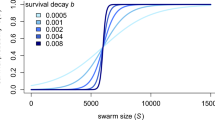Abstract
Previous tests for mating activity ofDrosophila persimilis homokaryotype KL (Klamath) and MD (Mendocino) chromosomal arrangements (northern California population: Redwoods) had shown KL to mate faster on the average than MD in homogamic tests. A strain (double-cross hybrid of four KL lines from the same population) with reliable high mating activity was developed for testing the sexes separately. Five pairs of KL-MD homokaryotype strains were chosen to be tested by the criterion that each pair had been derived from a separate wild KL/MD progenitor. Strains were crossed within arrangements in a diallelic design (20 inter- and five intrastrain crosses tested in 16 replicates per cross) to provide mating activity indices of four sets: KL females, KL males, MD females, MD males. Mating tests employed ten virgin experimental flies with ten tester (double-cross hybrid) flies of the opposite sex in 30-min observation periods. All flies were matured for 5 days at 25°C before testing. Among parental strains, females were consistently higher in mating activity than males for both KL and MD arrangements. Most interstrain hybrids were heterotic, with KL and MD females not significantly different. However, hybrid MD males displayed greatest variation and had lowest mating activity, while KL males were the least variable and highest in mating activity. With heterosis in the hybrids, there was no predictability (additivity) from performance of parental strains to hybrid offspring. Mating activities of the two sexes were uncorrelated, indicating either that the sexes have independent genetic systems controlling mating activity or that the expression of the same genetic system is influenced by sex. Since the hybrid males of the two karyotypes displayed different courtship activity while the females were at about an equal level of receptivity, intrasexual selection among males is likely to be important in nature.
Similar content being viewed by others
References
Fulker, D. W. (1966). Mating speed in maleDrosophila melanogaster: A psychogenetic analysis.Science 153:203–205.
Griffing, B. (1956a). A generalized treatment of the use of diallel crosses in quantitative inheritance.Heredity 10:31–50.
Griffing, B. (1956b). Concept of general and specific combining ability in relation to diallel crossing systems.Austral. J. Biol. Sci. 9:463–493.
Kaul, D., and Parsons, P. A. (1965). The genotypic control of mating speed and duration of copulation inDrosophila pseudoobscura.Heredity 20:381–392.
Manning, A. (1966). Corpus allatum and sexual receptivity in femaleDrosophila, Anim. Behav. 15:239–250.
Manning, A. (1968). The effects of artificial selection for slow mating inDrosophila simulans. I. The behavioural changes.Anim. Behav. 16:108–113.
Parsons, P. A. (1964). A diallel cross for mating speeds inDrosophila melanogaster.Genetica 35:141–151.
Parsons, P. A., Hosgood, S. M. W., and Lee, B. T. O. (1967). Polygenes and polymorphism.Mol. Gen. Genet. 99:165–170.
Robertson, A. (1955). Selection in animals: Synthesis.Cold Spring Harbor Symp. Quant. Biol. 20:225–229.
Sherwin, R. N., and Spiess, E. B. (1973). Chromosomal control of mating activity inDrosophila pseudoobscura.Proc. Natl. Acad. Sci. 70:459–446.
Shull, G. H. (1948). What is “heterosis”?Genetics 33:439–446.
Spiess, E. B. (1970). Mating propensity and its genetic basis inDrosophila. In Hecht, M., and Steere, W. C. (eds.),Essays in Evolution and Genetics in Honor of Theodosius Dobzhansky. Appleton-Century-Crofts, New York, pp. 315–379.
Spiess, E. B., and Stankevych, A. (1973). Mating speed selection and egg chamber correlation inDrosophila persimilis.Egypt. J. Genet. Cytol. 2:117–194.
Spiess, E. B., Langer, B., and Spiess, L. D. (1966). Mating control by gene arrangements inDrosophila pseudoobscura.Genetics 54:1139–1149.
Spiess, E. B., Sherwin, R. N., and Yacher, T. H. (1971). Mating propensity of gene arrangement carriers for a redwoods population ofDrosophila persimilis.Evolution 25:461–470.
Yacher, T. H., and Spiess, E. B. (1973). The development of mating propensity in two karyotypes ofDrosophila persimilis.Anim. Behav. 21:359–370.
Author information
Authors and Affiliations
Additional information
Work supported in part by National Science Foundation Grant GB 34206.
Rights and permissions
About this article
Cite this article
Spiess, E.B., Yu, HF. Relative mating activity of the sexes in homokaryotypes ofDrosophila persimilis from a redwoods population. Behav Genet 5, 203–216 (1975). https://doi.org/10.1007/BF01066812
Received:
Accepted:
Issue Date:
DOI: https://doi.org/10.1007/BF01066812




